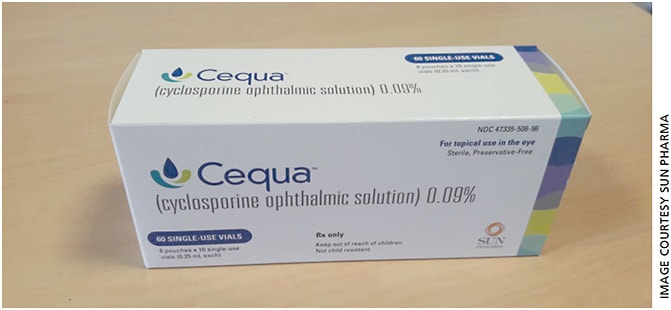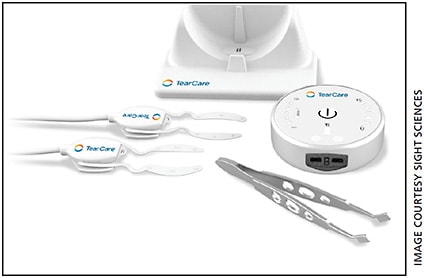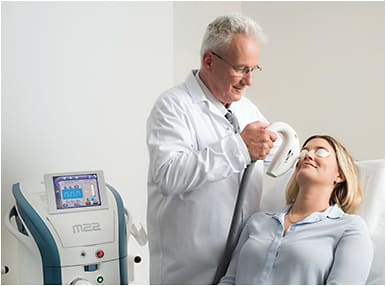Tear film instability and ocular surface inflammation are the hallmark signs of dry eye disease (DED), but DED itself has multiple etiologies. These range from medication use to gender/age to environmental variables to occupation. Prevalence rates are equally wide-ranging with this disease, with estimates ranging from 5% to 50% of the global population, according to the Tear Film & Ocular Surface Society Dry Eye Workshop [TFOS DEWS] II report. To further complicate this disease, no single treatment works for every patient, and it is uncommon for patients to present with a single isolated component of dry eye.
“Certainly we see those patients who simply have an aqueous deficient component or they have a component of meibomian gland disease (MGD) and evaporative loss, but it’s much more common to see mixed disease. We need to tailor our treatment towards all of the components that are present, which is what the CEDARS algorithm is based on,” says Jodi Luchs, MD, FACS, Florida Vision Institute.
Elizabeth Yeu, MD, Virginia Eye Consultants, looks at DED from three different perspectives, both diagnostically and for treatment: the systemic component (if any), normalizing the tear film and normalizing the ocular surface architecture. “The answers to those three components direct treatment,” she says.
A number of treatments are available for DED patients, both in the form of medications and procedures. Here, dry eye experts discuss their choices for treatment and explain their approach.
TOPICAL MEDICATIONS
Three pharmaceuticals are currently approved to treat dry eye: lifitegrast (Xiidra, Novartis), cyclosporine 0.05% (Restasis, Allergan) and cyclosporine 0.09% (Cequa, Sun Ophthalmics), the latter of which incorporates nanomicellar technology (Figure 1).

In addition to those, Dr. Yeu often uses steroids, particularly when the patient’s matrix metalloproteinase 9 (MMP-9) is positive or when having an anti-inflammatory component can provide added symptomatic relief. (MMP-9 is an inflammatory marker that is upregulated in dry eyes and tested via the InflammaDry test [Quidel]. The presence of high levels of MMP-9 is an indicator of ocular surface inflammation, typically related to dry eyes.) But, she added, if the eye is hot “the eye will likely burn, which means patient compliance and acceptance of treatment will be low,” she says. For those eyes, Dr. Yeu recommends adding topical steroids to cool or calm the eye during its acute phase, which will “absolutely help” patients accept treatments that (at the earliest) take 2 weeks and as much as six months to have an effect.
The first approach may not necessarily be the most effective, Dr. Luchs says, and advises clinicians to let patients know there isn’t a panacea for all disease symptoms. Let patients know treatment may need to be adjusted numerous times before finding the right combination, he says.
“None of these diseases that fall under the overall DED category exist on a straight line continuum; they have ebbs and flows,” Dr. Luchs adds. “There are periods where the disease will exacerbate, patients will have a flare up of symptoms, and periods where the disease will be quieter.”
On the horizon
In addition to those treatments currently in their armamentariums, dry eye experts weighed in on some of the developing treatments they are tracking that may soon become available.
Azura Ophthalmics is developing a keratolytic treatment that is showing some impressive results, Dr. Hovanesian says. According to Phase 1 data, the tear film break-up time improved from ~9 seconds to ~15 seconds (~65% increase) in the treatment group at Day 22 with no change in the control group (p=0.0008).
Dr. Majmudar says Novaliq’s NOV03, a “waterless drop,” acts like a shield on the eye to prevent evaporation. “This may be a great treatment for blepharitis and blepharitis-associated dry eye and evaporative dry eye,” he says; Bausch Health recently licensed the rights to NOV03.
Novaliq’s CyclASol has a higher concentration of cyclosporine than Restasis and Cequa, Dr. Hovanesian says. “Because it’s water-free, it can be delivered comfortably to the eye,” he says. NOV03 and CyclASol are both investigational drugs.
Tarsus is developing a topical treatment for ocular rosacea and Demodex blepharitis in addition to a cidal drug targeting Demodex, Drs. Yeu and Hovanesian say.
In the pipeline from TearClear is “an interesting gel matrix that removes the preservative from any topical drop, rendering it preservative free when it reaches the ocular surface,” Dr. Yeu says.
EyeDetec’s “eyelid lipid mobilizer” looks a bit like virtual reality goggles, says Dr. Hovanesian, but it uses vibration to loosen the meibomian glands.
Other notable developments include a patented, non-invasive, transdermal drug delivery platform designed for DED from Glaukos and mobile phlebotomy services that Vital Tears’ recently added to its system of providing autologous serum tears, Dr. Hovanesian says.
It’s clear that the more clinicians find out about dry eye, the more welcome additional tests and therapies are in the effort to continually streamline and perfect individualized treatments
“Our understanding of the science is going to expand pretty considerably,” Dr. Hovanesian says. “We need to welcome these new treatments as they become available but test them rigorously to evaluate how effective they are. After all, if you’ve seen one dry eye patient, you’ve seen one dry eye patient.”
TREATING MGD
MGD is a leading cause of ocular surface disease as well as evaporative dry eye. Treating it involves reducing inflammation in the meibomian glands, ensuring those glands are open and flowing and that they are producing a meibum as close to normal as possible, Dr. Luchs says. Mainstays of treatment include warm compresses and lid massage to melt the oils in the glands; other treatments can include topical steroids, oral or topical doxycycline to reduce inflammation and azithromycin to help with eyelid issues; more aggressive pharmaceutical treatments may include metronidazole (especially when an ocular rosacea component is present) or topical hormone therapy, these physicians say.
In terms of in-office MGD treatments, the LipiFlow Thermal Pulsation System (Johnson & Johnson Vision) is one option; Dr. Luchs likens it to getting your teeth cleaned.
“You see your dentist once or twice a year for a teeth cleaning, and then you go home and brush your teeth in between visits. It’s the same thing with LipiFlow — it’s a great adjunct to our overall MGD treatments,” he says.
Two additional procedural treatments may treat MGD as well as Demodex: iLux (Alcon), which uses LED light to raise the eyelid temperature and melt blockages, and TearCare (Sight Sciences), a wearable eyelid technology (Figure 2), says John A. Hovanesian, MD, Harvard Eye Associates.

“We’re only starting to understand who are the best candidates for these treatments,” he says.
For patients with Demodex, Dr. Luchs recommends BlephEx with a tea tree oil foam to the lid margins.
Again, Dr. Yeu stresses the importance of customizing the treatment approach for each patient. “With MGD, we need to know what the gland architecture looks like and what their tear diagnostics look like to best treat our patients.”
In addition, topical cyclosporine can have beneficial effects on the meibomian glands (in an off-label use), Dr. Luchs adds.
OTHER TREATMENT REGIMENS
Beyond topical medications and office-based procedures, Dr. Yeu may use TrueTear (Allergan), a nerve stimulation device “that provides patients with a more complete tear film to coat their nerves, especially the oily component in meibum that helps to decrease patients’ symptomatology.”
Using milder steroids for longer periods of time (4-6 weeks) can give patients that “initial bump to decrease inflammation,” says Parag Majmudar, MD, Chicago Cornea Consultants. Still, clinicians should remain vigilant about monitoring IOP and cataract formation. Dr. Majmudar has found intense pulsed light (Optima IPL system, Lumenis) useful for controlling inflammation in both DED and MGD (Figure 3). In addition, the treatment “allows us to tailor a treatment plan for someone who may have other financial constraints,” he says.

Amniotic cytokine extract drops (Genesis (Ocular Science) and Regener-Eyes) have shown some of the same types of anti-inflammatory benefits as amniotic membrane, says Dr. Yeu. She says compounding pharmacies may be able to provide serum tears or albumin tears; the CEDARS algorithm also suggests other compounded formulations. (She noted the CEDARS algorithm is more diagnostic-based than the TFOS DEWS recommendations, which are more severity based.)
CONCLUSION
Keep in mind that not every treatment works for every patient. “That’s the frustrating aspect of DED,” Dr. Majmudar says. Also, as one treatment fails or another needs to be added, costs increase.
But, with an abundance of available treatment options at their disposal, clinicians have a number of ways to address this unique disease and provide relief for their patients. OM








